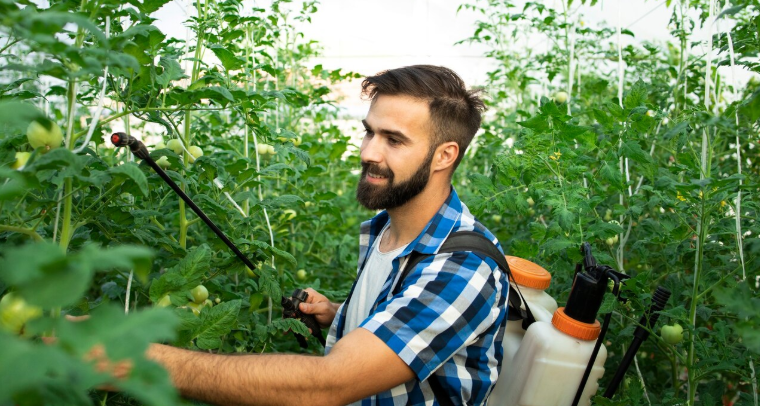
Seeing Beyond the Surface: Unveiling the Enemy with AI-Powered Eyes
Precision Strikes: Targeting Enemies with Surgical Efficiency
Traditional pest control often treats entire fields like homogenous battlegrounds, unleashing broad-spectrum chemicals that harm not only pests but also beneficial insects and the environment. But AI-driven pest control ushers in an era of targeted warfare, transforming farmers into sharpshooters in the fight against agricultural adversaries. Imagine robotic weeders equipped with AI-powered vision systems, meticulously identifying and eliminating unwanted plants while leaving crops unscathed. Envision drones armed with laser-guided sprayers, delivering precise doses of biopesticides directly to infested areas, minimizing chemical use and protecting ecological balance. This AI-powered precision ensures every strike against pests hits its mark, maximizing efficacy while minimizing collateral damage to both crops and environment.
Resilience Built on Prediction: Weathering the Storm with Proactive Measures
Climate change and unpredictable weather patterns present formidable challenges for pest control. But AI-driven pest control arms farmers with the power of proactive resilience. Imagine weather monitoring systems analyzing vast datasets and employing AI algorithms to predict periods of high pest activity or disease outbreaks. Envision early warning systems sending real-time alerts to farmers, allowing them to deploy preventative measures like pest traps, pheromone lures, or targeted spraying even before the first signs of trouble appear. This AI-powered resilience provides farmers with a crucial head start, safeguarding their crops against the unpredictable forces of nature and minimizing potential losses.
Beyond Yield: Cultivating a Sustainable Future with Every Intervention
AI-driven pest control is not just about maximizing yields; it’s about nurturing a sustainable future for our planet. Imagine optimizing irrigation based on real-time data gleaned from sensors and aerial imagery, minimizing water waste and reducing breeding grounds for water-borne pests. Envision biopesticide applications tailored to specific pests and their life cycles, minimizing harm to beneficial insects and preserving biodiversity. This sustainability-focused approach, empowered by AI, ensures abundance thrives alongside environmental responsibility, safeguarding our planet’s resources for generations to come. With every AI-driven pest control intervention, farmers cultivate not just bountiful harvests but a thriving and sustainable ecosystem, leaving a legacy of environmental stewardship for future generations.
Connecting Fields to the Cloud: The Power of Collective Intelligence
AI-driven pest control thrives in a connected ecosystem. Imagine farmers across continents sharing data on specific pest species, resistant crop varieties, and regional weather patterns through cloud platforms. Envision collaborating with agricultural experts and researchers around the globe, analyzing combined datasets fueled by AI to identify emerging pest trends and develop best practices applicable to diverse agro-climatic environments. This collaborative network fosters innovation, accelerates problem-solving, and empowers farmers to learn from each other’s successes, regardless of geographical location. With every shared insight, the agricultural community strengthens, propelling the industry towards a brighter future where AI-driven knowledge flourishes without borders.
Data-Driven Decisions: From Intuition to Actionable Insights
AI-driven pest control is a symphony of data, but its power lies in transforming data into action. Imagine real-time dashboards visually presenting key metrics about pest activity, potential outbreaks, and the effectiveness of deployed control measures. Envision historical data and current conditions layered upon each other, revealing emerging trends and opportunities for improvement. This data-driven approach guides farmers towards informed decisions, allowing them to optimize pest control strategies, predict potential problems before they arise, and navigate the complexities of modern agriculture with unparalleled clarity. With every actionable insight gleaned from AI, farmers transform intuition into data-driven decisions, propelling their farms towards a future of resilience and bountiful harvests.
Innovation Redefining Pest Control
The world of AI-driven pest control is constantly evolving, with cutting-edge advancements emerging each day. Imagine autonomous robots equipped with advanced sensors patrolling fields, identifying and eliminating pests in real-time. Envision gene editing technologies creating pest-resistant crop varieties, reducing reliance on pesticides altogether. This future promises even greater safeguarding of crops through advanced AI-powered solutions, ushering in an era of sustainable and efficient pest control that protects both harvests and the environment.
Additional Resources
- Key components and revolution driving the Smart Farming technologies
- Precision Harvesting: Maximizing Yield with Smart Crop Collection
- The Role of IoT in Modern Agriculture: A Precision Approach
- AI-Driven Pest Control: Safeguarding Crops
Additional Learning
https://aprykot.com/herbalism/herbal-teas/herbal-teas-for-digestive-harmony
Categories
Latest Post’s
FAQs
How are robotics and automation redefining farm labor?
Robotics and automation are redefining farm labor by shifting the focus from strenuous manual tasks to more technologically advanced roles. Autonomous tractors, robotic harvesters, and automated weeding systems take over repetitive and physically demanding jobs, allowing the agricultural workforce to focus on managing technology, analyzing data, and strategic decision-making.
What specific tasks can agricultural robots perform?
Agricultural robots are becoming increasingly versatile. They can perform a wide range of tasks, including:
- Precision planting: Sowing seeds with pinpoint accuracy.
- Targeted weeding: Using lasers or precise sprayers to remove weeds without disturbing crops or using excessive chemicals.
- Automated harvesting: Gently picking delicate fruits and vegetables at optimal ripeness.
- Data collection: Monitoring soil health, crop growth, and pest presence using sensors and AI.
How does automation improve farm efficiency and productivity?
Automation significantly improves efficiency and productivity by enabling 24/7 operations without human fatigue. Robotic systems work with a high degree of precision, reducing errors and optimizing resource use. For instance, they can apply fertilizers and pesticides only where needed, leading to better yields and lower costs.
What is the role of AI and data in the future of farm labor?
AI and data are central to the future of farm labor. Sensors collect real-time data on everything from soil moisture to plant health. AI-powered software then analyzes this information to guide automated machines and provide farmers with actionable insights. This data-driven approach allows for more informed decisions and a more resilient farming system.
Will robotics and automation lead to job losses in agriculture?
The rise of robotics and automation will lead to a shift, rather than a total elimination, of jobs. While some low-skilled, manual labor roles may be displaced, new opportunities will emerge for a workforce skilled in operating, maintaining, and repairing agricultural robots and data systems. The future workforce will be more focused on technology and data management.
How do these technologies contribute to sustainability?
Robotics and automation contribute to sustainability by enabling precision agriculture. This includes the targeted application of water and nutrients, which reduces waste and prevents chemical runoff. Furthermore, robotic weeding systems can lessen the need for herbicides, protecting soil health and biodiversity.
What are the main challenges to adopting agricultural robotics?
Key challenges include the high initial investment cost of robotic equipment, the need for robust rural internet infrastructure to support data exchange, and the requirement for farmers and workers to acquire new technical skills. These factors can create a barrier to entry, particularly for smaller farms.
How will automation change the skills needed for farm work?
The skills required for farm work are evolving from physical strength and manual labor to technical and analytical skills. Future farm workers will need to be proficient in data analysis, software management, and robotics maintenance to effectively operate the new automated systems.
How do autonomous systems help farms deal with climate change?
Autonomous systems can help farms build resilience against climate change by adapting to a range of conditions. For example, they can operate in extreme heat and other weather conditions that might be unsafe for humans. Additionally, they can provide real-time data to help farmers adjust to unpredictable weather patterns and manage resources like water more effectively.
How can smaller farms afford and access these new technologies?
As technology becomes more widespread, the costs are expected to decrease. Additionally, new business models, such as leasing services and “as-a-service” platforms, are making it possible for smaller farms to access sophisticated equipment without a massive upfront investment. Government subsidies and collaborative initiatives can also help democratize access to these technologies.


